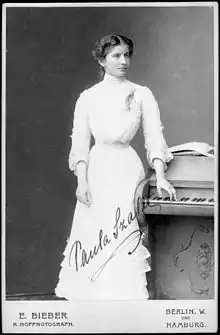Paula Szalit
Paulina Szalitówna (1886 or 1887—1920), more commonly known as Paula Szalit was a Polish pianist and composer.

Paula Szalit was born in Lemberg (today Lviv) in 1886.[1] She studied at what is now the Lviv Conservatory and then in Vienna with Robert Fischof, Josef Hofmann,[2] Heinrich Schenker,[3] Eugen d'Albert, and Theodor Leschetizky.[1]
Szalit was regarded as a child prodigy and made numerous appearances in Vienna, Germany and Poland.[1] She received generally superlative notices, such as these:
"The musical clientele at Vienna are much interested in an infant phenomena, Paula Szalit, aged ten. When she was scarcely out of long clothes, she would pick out on the piano, with one finger, the notes of a tune that she had heard sung, and long before she had any idea of printed notes she would play melodies of her own composition—songs, dances, etc. Her musical adroitness was not cultivated until she was seven years old, when she was given lessons, first by her brother, and later by Prof. Fischof and by Eugen d'Albert. It is said that little Paula's playing is charming, not only because of her clear technique and vigorous tone, astonishing from hands so small that they can scarcely stretch an octave, but also because of the artistic feeling she displays. Little Paula has very sensible parents who see that she does not overtax her strength. She has never toured in concert but has appeared in public in Vienna, Prague, and Berlin."[4]
And another review:
"She is mistress of her instrument in every respect; she understands its genius. As far as technique in the ordinary sense goes she has nothing to learn. . . . Her phrasing had the quality of inevitableness, which can never be the effect of the mediocre mind in music. . . . Miss Szalit has also the mind that grasps the inner meaning of the art; the spirituality that sees in it more than sensuous tonal beauty...By almost universal consent she has been recognised as an artist of quite exceptional attainments."[5]
Occasionally her reviews were more muted, such as this:
"Her readings of works by Beethoven, Mendelssohn, and Chopin were lacking in depth of sentiment, but they displayed an intelligence and musical feeling which, combined with a sympathetic touch and great executive facility, testify to exceptional ability." [6]
She was described by Niemann as "a veritable phenomenon of pianistic and musical talent." [2] Artur Schnabel deemed her the greatest child prodigy in history.[7]
Nieman remarked that she could transpose at sight.[2] Bie said she could transpose fugues at sight.[8]
She died in 1920.
Works
For piano unless noted.[9]
- Intermezzo in G sharp
- Praeludium
- Carpiccio (F minor)
- Miniatures
- Morceaux, op. 2 (1900):
- 1. Rêverie
- 2. Impromptu
- 3. Tendresse
- 4. Scène de Ballet
- 5. Mazurka
- 6. Valse
- 7. Intermezzo
- 8. Gavotte
- Traeumerei (1897)
- Intermezzo, Op. 3, no. 3.
- Impromptu in F, Op. 3
- Im Winter: „Schlaf ein, mein süsses Kind“ (1897) (for voice and piano)
References
- Bie, Oscar. Das Klavier und seine Meister. Munich: F. Bruckmann, 1898.
- Niemann, Walter. Meister des Klaviers. Berlin: Verlegt bei Schuster Loeffler, 1919.
Notes
- Aaron I. Cohen, "Szalitowna (Szalit), Paulina" in: International Encyclopedia of Women Composers, New York: Books & Music (1987), p. 683.
- Nieman, p. 155.
- Hellmut Federhofer, Heinrich Schenker: Nach Tagebüchern und Briefen in der Oswald Jonas Memorial Collection, University of California, Riverside (Hildesheim: Georg Olms Verlag, 1985), p. 60.
- (Untitled notice), Werner's magazine (Chicago: Werner's Magazine, v. 19 (Jan.-Aug. 1897), p. 346.
- E.A.B. as quoted in The Academy and Literature, Jan. 30, 1904, p. 130.
- "London Concerts and Recitals: Pianoforte Recitals," Musical Times Feb. 1, 1904, p. 120.
- Harold C. Schonberg, The Great Pianists, (New York: Simon and Schuster, 1963), p. 353.
- Bie, p. 319.
- Dates from Hoffmeister.